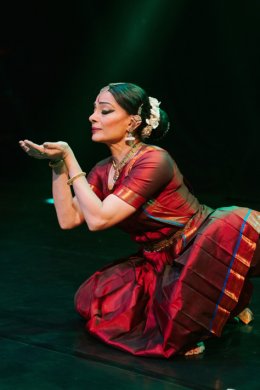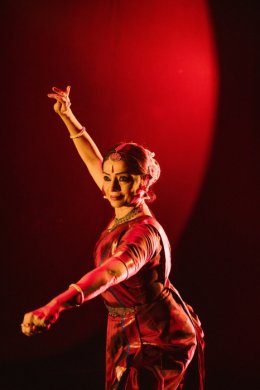
|   |

|   |
 e-mail: leelakaverivenkat@gmail.com Anubandh- Scintillating blend of collaborative inputs with performative excellence September 25, 2022 The HCL sponsored concert at Kamani auditorium, attracting Delhi's art cognoscenti, featuring Malavika Sarukkai's scintillating post-pandemic maiden offer Anubandh (meaning connectedness) could not have been better timed- coming as it did, after the harrowing period of forced isolation, with loneliness fracturing all relationships. And what better call to the transformative power of hope could there be, than one reclaiming man's primordial relationship with the elements forming the world he lives in -viz the sun and the moon, Prithvi or earth providing the grounded security and living space, Apah or water sustaining life's thirsts, Vayu wafting sweet nothings across space, fanning the fires of passion, Agni or fire destroying and igniting grief and Akash or space providing that release into vastness.  In Malavika Sarukkai's works, one has come to expect that keen eye for detailing which is her hallmark. And in Anubandh, that concern for excellence begins with the elegant brochure - with the theme for the evening of Mahabhutas Anaaser Elements, introduced in a delightfully informative essay by none other than Dr. B.N. Goswamy, renowned art critic and Professor Emeritus, Punjab University. Mentioning how the elements are treated in different cultures, and deified in Indian scriptures which stress on the recycling process of the universe - with man who is made up of the five elements, after death, dissolving and getting interred with the same Mahabhutas again, Dr. Goswamy enriches the essay with several poetic quotes from different cultures. This critic was most moved by Sardar Jafri's words "Phir ek din aisa ayega....."mentioning the day (when the lotuses of my hands will wilt, the lamps of my eyes will begin to grow dim, and from the branch that is my tongue, all butterflies of speech and articulation will fly away one by one...) with the body dissolving and going back to what it was made up of. Looking with a sensitive artistic eye at man's connectedness with the universe, Malavika takes the audience through a gripping journey "from the familiar to the unfamiliar, from the known to the unknown........" with the narrative of the dance moving "from the personal to the shared and from the individual to the collective." Looking at the production itself, while giving full credit to the ideational richness of a collaborative enterprise, with Sumantra Ghosal's contribution of English poems, brilliant music design of Sai Shravanam, realized through an excellent team of musicians both vocalists and instrumentalists, Easwar Ramakrishnan's ragas with specific notes evoke the mood of a sequence, and the extraordinary light designing of Niranjan Gokhale - a varied package, which required the alchemy of Malavika's performative excellence to come together, to make a potent statement. And with the pandemic cutting out live exchanges, requiring each participant to work separately perhaps helped by the odd Zoom exchange, the kind of confidence each placed in the others, shows how much of a meeting of minds the entire enterprise was. As far as the dancing was concerned, the dancer's amazing stamina for pulling off a nonstop, one hour thirty minute solo production, was nothing short of a miracle. Rendered at a savoured and intensely concentrated, vilambit laya, with only the odd recourse taken to a passing nritta punctuation, the meditative inward quietude demanded from the performing dancer, was phenomenal. And some images stood out - the Aditya Hridayam chant by Malola Kannan visualized as the powerful Sun God astride his chariot, driven by (seven) horses; the Prithvi mantra chant with the rishabham of Saveri ragam evoking an earthy note as the dancer, tracing her hands lovingly on the floor, cherishes the intimacy with earth - her lebensraum. The quencher of life's thirst and from whom all life flows - Apah, with sounds of flowing water and Murali Parthasarathy's voice rendering raga Varamu with the dominant gandhar, is seen by the dancer as the pitter patter of rain, as a cascade of waterfall, as a mere ripple in the pond or even as the raging sea. With Vayu set to raga Behag rendered by N. Bhagyalakshmi, the season of Spring is ushered in, stirred by messages of love wafted across spaces. Familiar images of blooming nature with bees drunk on honey, the cuckoo bird calling and Manmatha's flowered darts stirring intoxicating desire follow. In the next image, superb light on the fluttering fingers of the seated dancer, creates the potent image of burning embers, as the powerful Agni mantra is chanted followed by Sumantra Ghosal's poem on Fire, projecting this element as the force of ultimate transformation. And the tenor of the performance too suddenly changes, with the discordant elements of death, of destruction and of war, with the textual part based on a Sangam Purananuru lyric on the brutally murdered King Pari. Set to evocative music by Vasudha Ravi in ragas Subhapantuvarali and Mohanakalyani, the dancer's cutting and thrusting moves express horror at a world gone mad with hatred - showing man causing grief to himself and to others of his ilk. Connectedness with fellow beings is snapped, with discord erecting impenetrable walls of destruction. The lighting effects creating those impenetrable walls running across the stage, along with the music, comprising scattered note phrases, suddenly losing unison of rendition to become a superb metaphor expressing that discord, is a feature of the production.  The wall of misunderstanding can be removed only with realization seeping in when man wakes up to the wonderment of Akash evoking the feel of shanti or freedom, the vastness of space recognizing no boundaries. Here is the macro reality- the life breath (prana) pervading all. And as the ocean tides rise and fall with sunset and sunrise, life will roll on, with its ups and downs, of joy and sorrow. And apart from Sumantra Ghosal's poem and Uday Bhawalkar's dhrupad music in raga Hindol, come the final words of Sant Kabir about human connectedness, "The Lord is in me, the Lord is in you, just as prana (life breath) is in the seed." Quite different from the usual run of Bharatanatyam productions, based on this mixed bag of lines from Ramayana's Aditya Hridayam and Gayatri mantras on the Mahabhutas, snatches of poetry from Sangam Purananuru (2nd-5th century), words from Sant Kabir, English poetry, Dhrupad music and much else, Malavika's movement choreography was equally unique. What her choreography created was a blend of an organic response to situations along with highly stylized Bharatanatyam idiom, in a clever blend of lokadharmi along with uncompromising classicism. While the purist (which Malavika has been in her devotion to classicism) may cavil at what comes like an extension of the classical form, those who laud experimentation, will applaud it. In the final analysis, after all the action, when the curtain came down on a dancer at peace, squatting on the floor, face framed in the V of two hands folded at the elbow, one felt that one had been on a unique art journey.  Writing on the dance scene for the last forty years, Leela Venkataraman's incisive comments on performances of all dance forms, participation in dance discussions both in India and abroad, and as a regular contributor to Hindu Friday Review, journals like Sruti and Nartanam, makes her voice respected for its balanced critiquing. She is the author of several books like Indian Classical dance: Tradition in Transition, Classical Dance in India and Indian Classical dance: The Renaissance and Beyond. Post your comments Pl provide your name and email id along with your comment. All appropriate comments posted with name and email id in the blog will also be featured in the site. |